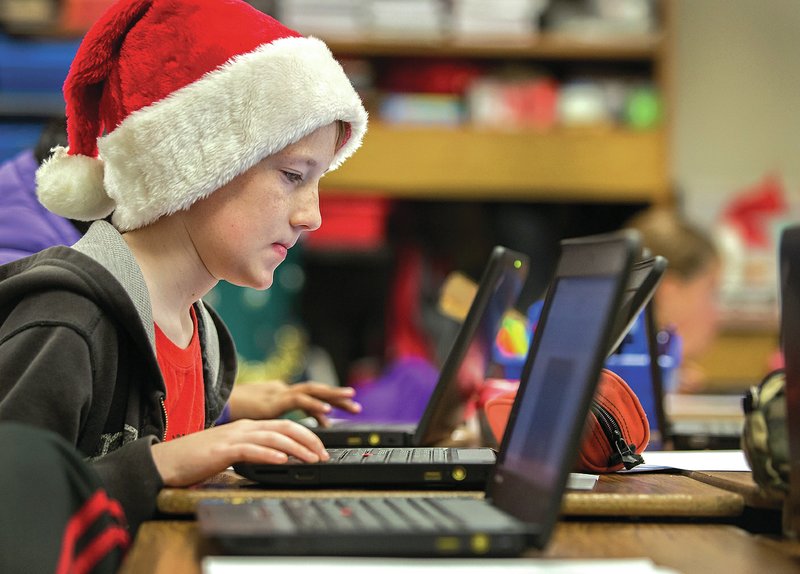ROGERS -- Students in Kim Hamilton's fifth-grade class at Bellview Elementary School rattled off the facts they found during research on Native American tribes during presentations last week.
They listed weapons of the Iroquois and Sioux, food of the Hopi and Cherokee, children's games and war dances as each report lit up the electronic screen behind them. Students prepared an electronic report using books from the classroom and their own Internet research.
Fast Facts
Internet Flashback
The Internet wasn’t always part of school. According to the Pew Research Center, 28 percent of surveyed adults reported they first used the Internet between 1995 and 1999, and 29 percent reported their first Internet use was between 2000 and 2004. Here’s some more fun facts:
1990
• 42 percent of adults surveyed reported they had used a personal computer.
2014
• 81 percent of adults said they use computers at home or at work.
1995
• 14 percent of adults surveyed reported they had Internet access, and 42 percent had never heard of it.
2014
• 87 percent of adults surveyed reported they used the Internet. Of those users, 52 percent said it would be very hard to give up it up.
Source: Pew Research Center
Hamilton taught them different presentation software and asked them to include a video in each presentation.
The hard part was narrowing down a topic, said student Julia Davis. Preparing the report was easier on a computer because she's familiar with how to do it, she said. Doing the research was harder on the computer than a using book because the Internet never has just one answer, but many.
"It could give you a million things, and you're not going to read a million things," Julia said of her search returns.
Jenna Kate Bohnert's presentation took more information than she thought it would. She used the slide presentation software Prezi.
"You need a lot of information for that because it has a lot of circles, and, honestly, I don't know how to delete them," she said.
Once he found all the information for his report, Richard Wood said he felt like he'd hit the jackpot.
"It was kind of like a scavenger hunt," he said.
Sifting through piles of information and making a usable presentation are skills they'll need in the future, Hamilton said. Students used PowerPoint presentations, Padlet and Lino, an electronic sticky note program, to create their presentations.
"Everybody I know in every field has to do everything on computer," she said.
Schools are working to get more computers into the hands of students. At Bellview that means teachers apply for technology grants, and state money awarded to high-performing schools goes to laptop computers, said Dan Cox, principal.
He's purchased ThinkPads with part of the $54,229 the school was awarded for being ranked in the top 10 percent of Arkansas schools in student performance or academic growth in 2013. He also used part of the $43,556 the school was awarded in 2014. Student test scores are used to calculate the top 10 percent and 20 percent of Arkansas schools which are then given reward money and discretion on how it is spent.
The Rogers School District also has a millage dedicated to technology.
ThinkPads function as a full laptop computer, Cox said. He estimates there are about three children for every one computer at Bellview Elementary.
In 10 to 20 years, Cox said he expects every school will have a computer for every student that functions as a textbook and research center. Technology use in the classroom is still growing, but it's too soon to say every child needs a computer every day, he said.
"I don't think it would get used," he said.
In some earlier grades, teachers worry they won't have time to add computer skills to reading, writing and arithmetic, he said. The earlier the better when it comes to technology, Cox said.
"I don't think they are too young at kindergarten to be working on laptops," he said.
Hamilton works out a schedule in advance to get computers to her classroom. Most of her students came to class knowing how to use a computer, but at the beginning of the year, they went through making folders, saving work, uploading videos and making presentations. Building a foundation of computer literacy at a young age will help them as they get older, she said.
Cox said he is working to get a mobile lab of 30 computers for every grade level, kindergarten through fifth, in his school.
"We want to get to the point where that's just how we do business," Cox said.
NW News on 12/26/2014
